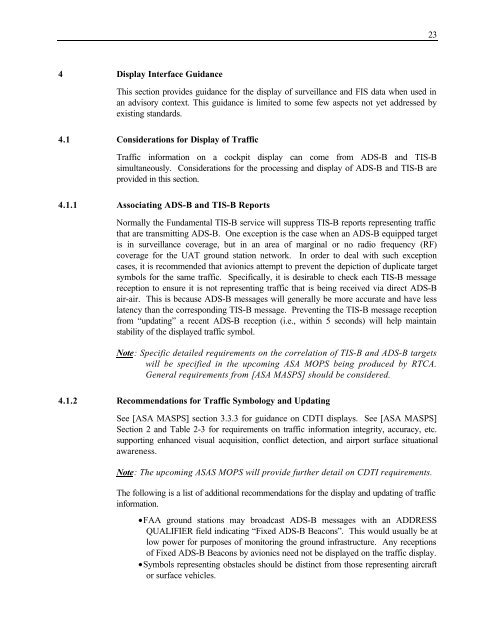Interim Guidance for UAT Avionics Operating with Safe Flight 21 ...
Interim Guidance for UAT Avionics Operating with Safe Flight 21 ...
Interim Guidance for UAT Avionics Operating with Safe Flight 21 ...
Create successful ePaper yourself
Turn your PDF publications into a flip-book with our unique Google optimized e-Paper software.
4 Display Interface <strong>Guidance</strong><br />
This section provides guidance <strong>for</strong> the display of surveillance and FIS data when used in<br />
an advisory context. This guidance is limited to some few aspects not yet addressed by<br />
existing standards.<br />
4.1 Considerations <strong>for</strong> Display of Traffic<br />
Traffic in<strong>for</strong>mation on a cockpit display can come from ADS-B and TIS-B<br />
simultaneously. Considerations <strong>for</strong> the processing and display of ADS-B and TIS-B are<br />
provided in this section.<br />
4.1.1 Associating ADS-B and TIS-B Reports<br />
Normally the Fundamental TIS-B service will suppress TIS-B reports representing traffic<br />
that are transmitting ADS-B. One exception is the case when an ADS-B equipped target<br />
is in surveillance coverage, but in an area of marginal or no radio frequency (RF)<br />
coverage <strong>for</strong> the <strong>UAT</strong> ground station network. In order to deal <strong>with</strong> such exception<br />
cases, it is recommended that avionics attempt to prevent the depiction of duplicate target<br />
symbols <strong>for</strong> the same traffic. Specifically, it is desirable to check each TIS-B message<br />
reception to ensure it is not representing traffic that is being received via direct ADS-B<br />
air-air. This is because ADS-B messages will generally be more accurate and have less<br />
latency than the corresponding TIS-B message. Preventing the TIS-B message reception<br />
from “updating” a recent ADS-B reception (i.e., <strong>with</strong>in 5 seconds) will help maintain<br />
stability of the displayed traffic symbol.<br />
Note: Specific detailed requirements on the correlation of TIS-B and ADS-B targets<br />
will be specified in the upcoming ASA MOPS being produced by RTCA.<br />
General requirements from [ASA MASPS] should be considered.<br />
4.1.2 Recommendations <strong>for</strong> Traffic Symbology and Updating<br />
See [ASA MASPS] section 3.3.3 <strong>for</strong> guidance on CDTI displays. See [ASA MASPS]<br />
Section 2 and Table 2-3 <strong>for</strong> requirements on traffic in<strong>for</strong>mation integrity, accuracy, etc.<br />
supporting enhanced visual acquisition, conflict detection, and airport surface situational<br />
awareness.<br />
Note: The upcoming ASAS MOPS will provide further detail on CDTI requirements.<br />
The following is a list of additional recommendations <strong>for</strong> the display and updating of traffic<br />
in<strong>for</strong>mation.<br />
• FAA ground stations may broadcast ADS-B messages <strong>with</strong> an ADDRESS<br />
QUALIFIER field indicating “Fixed ADS-B Beacons”. This would usually be at<br />
low power <strong>for</strong> purposes of monitoring the ground infrastructure. Any receptions<br />
of Fixed ADS-B Beacons by avionics need not be displayed on the traffic display.<br />
• Symbols representing obstacles should be distinct from those representing aircraft<br />
or surface vehicles.<br />
23
















